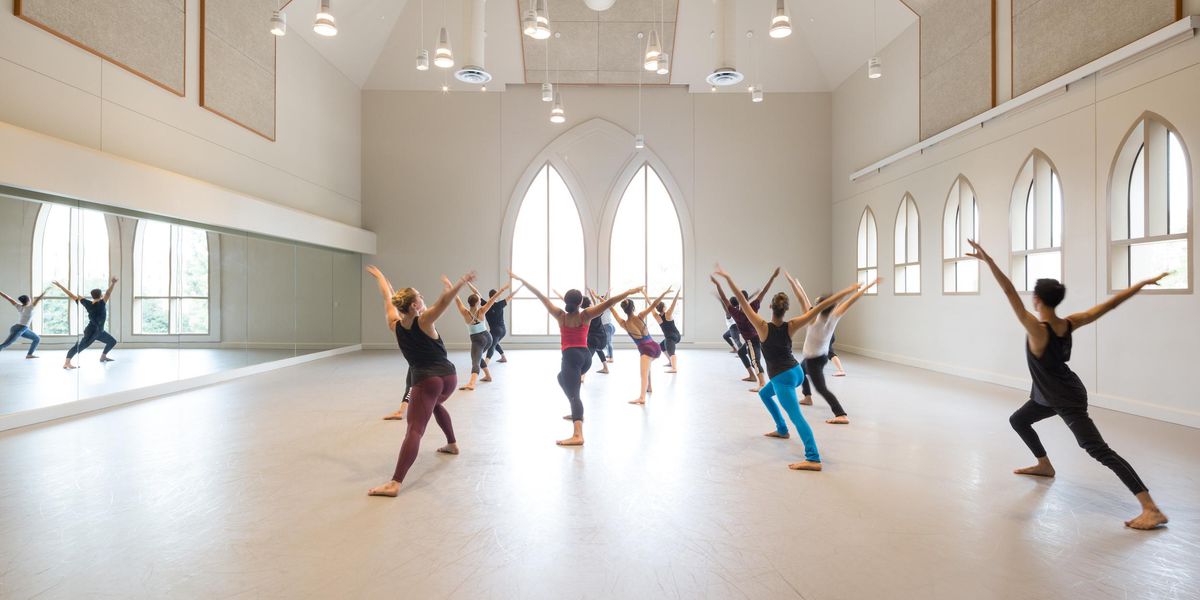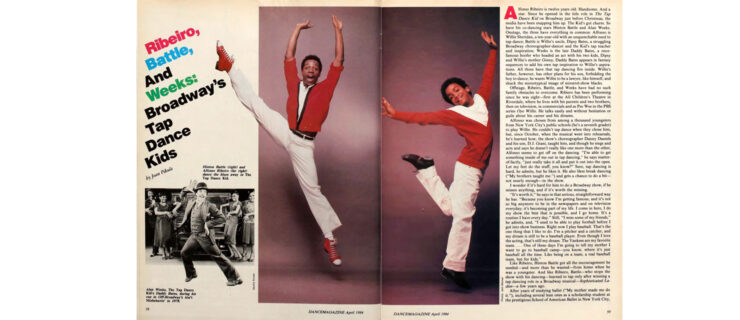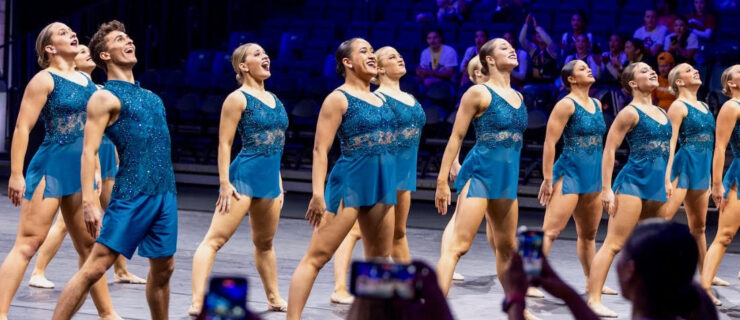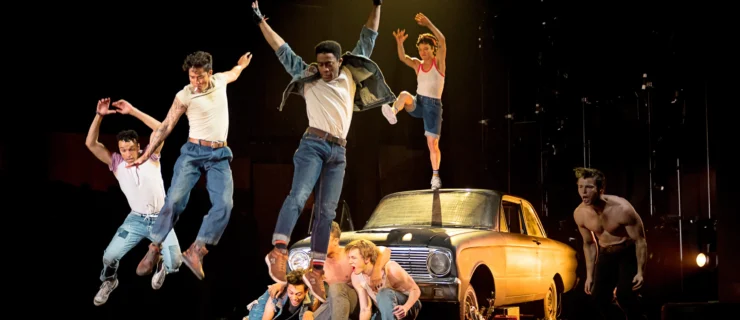Exploring New Ground
After retiring from the Paul Taylor Dance Company
to undergo a hip replacement, Annmaria Mazzini began the quest for her second act. If she wanted to dance again, she might need to alter her spectacularly visceral, physical style of dancing to exclude hurling herself onto the floor. “I wanted to find out what kind of dancer I was post-Taylor,” says Mazzini. After choreographing her first piece, Changeling, on dancers from the Taylor School, she says, “I wanted to create a job for myself and for other dancers. And I wanted to do it before people forgot me.”
And so, she formed Mazzini Dance Collective.
Pictured above: Sylvana Tapia, Andy Jacobs, and Audra Baily of Mazzini Dance Collective
Why start a company in 2013 when so many odds are against you? Each director has her own reasons, whether personal or political, to establish an individual esthetic. The older template of forming a company typically sprang from a choreographer showcasing his work in a series of concerts, usually for five years or more, on dancers steeped in a style of movement. That’s not always the case now. Today’s hopefuls often prefer to plunge in headfirst, whether out of ambition, creative frustration, pragmatism, or hubris. Some of them wish to dance, direct, and choreograph, while others want to focus only on being the boss and choosing repertoire from other choreographers.
Ron De Jesús
, a former Hubbard Street dancer and freelance choreographer who sets Twyla Tharp’s pieces for dance companies, grew frustrated with the lack of time to develop or rehearse works. When he choreographed on other companies, he felt he never had time to cultivate his movement language. “I can work fast, but the companies were getting more demanding,” says De Jesús. “That’s not how I want my craft to be. Even to set In the Upper Room, which normally takes two months, they want it done in a week. As a guest artist, you’re a dollar bill. They try to squeeze as much out of you.” His idea: “If I got a handful of dancers who inspire me and there’s no pressure, I could create a platform, a pure exchange of artistry and a more incubative environment, instead of the pounding of a dollar bill.” (Like some new directors, he hires his dancers “à la carte,” which frees them to do other projects.) In 2010 De Jesús received a grant from the Joyce SoHo in New York, and after a few concerts, moved back to his hometown of Chicago and founded Ron De Jesús Dance.
Above: Michel Rodriguez Cintra (aloft) and Benjamin Holliday Wardell of Ron De Jesús Dance
A former New York City Ballet and Los Angeles Ballet dancer, Melissa Barak has branded herself by choreographing for companies over the last decade. Now she says she wants to create a deeper choreographer/dancer relationship. Despite the wonderful experiences she had as a dancer and choreographer (and not so wonderful ones, like being notified by e-mail in 2011 that her Los Angeles Ballet contract was terminated), she wanted to tap into her full creative potential.
Kelly Ann Sloan and Carlos Lopez of Barak Ballet
“There was a lack in the dynamic of the relationship I was looking for as a dancer and an artist with some of the directors,” she says. “I wanted to take matters into my own hands. I wanted to create the kind of place I had always wished for that would be supportive.” Her vision for Barak Ballet, based in her hometown L.A., includes a repertoire of all new contemporary ballets and a healthy working environment for dancers. Using her connections, she wants to present works by choreographers such as Christopher Wheeldon, Darrell Grand Moultrie, and Frank Chaves (who were presented on her March 2013 prelaunch program in Santa Monica), as well as her own ballets.
In some cases, learning from past experiences helps a choreographer envision a company model. Former Dan Wagoner and Dancers member and current Rutgers University professor Randy James piloted his own company for 15 years, but disbanded it in 2008, partly due to a personal loss and the workload of teaching full-time and directing. “I was running a company model just like Dan Wagoner and practically everybody else was doing,” says James. “We would have a two-week rehearsal period for a New York season, and you had to spit out a piece. That’s not the way I want to run a company.” He realized he loved to choreograph but didn’t love doing everything else himself.
Alex Biegelson of 10 Hairy Legs in
Together We Stand by Manuel Vignoulle
After raising the quality of the male dancing at Rutgers, he created a piece for his male students titled Pillar of Salt. “I choreographed that dance and came back to my office and cried,” says James, because he didn’t have anywhere to showcase it. James devised a new model: a company with a base of five men (“I liked the number five—they could fit in a minivan with me driving”) to dance his own works plus pieces he had loved over the years by choreographers like Claire Porter, David Dorfman, and David Parker. He assembled a board of well-connected entrepreneurs and corralled a staff of people to do the things he didn’t love doing. His company, 10 Hairy Legs, performed at New York Live Arts in May, to positive reviews.
For those with an overabundance of fervor, running their own show may be the only way to go. American Ballet Theatre soloist and opera buff Craig Salstein, whose exasperation with traditional ballet companies feels close to its combustion point, has formed his own part-time company, Intermezzo. The troupe’s premiere performances will give choreographers Marcelo Gomes, Lisa de Ribere, Adam Hendrickson, Gemma Bond, and Raymond Lukens the opportunity to create ballets to the music of Giuseppe Verdi played live. The dancers include former New York City Ballet and ABT members, plus Aran Bell, the very young competitor who made an impression in the documentary film First Position. “ABT does a lot of repeating and reviving,” says Salstein. “This is a bit of a problem. It seems like the dance world has become a place where stars have become anointed by an individual.” Salstein admires the democratic attitude of Mark Morris’ company and wants a similar model for his classical troupe. After establishing its 501(c)(3), not-for-profit status, Intermezzo has begun.
Above: Craig Salstein teaching at Central Pennsylvania Youth Ballet
One of the more innovative approaches has been that of Laboratory Dancers. Based in Chicago, the group was formed by 10 graduates of Columbia College Chicago who enjoyed working together and had similar ideas about removing the barrier between performers and audience. They produce affordable shows in informal settings like lofts, house parties, and bars, as well as more formal performances. As a collective, they share the workload from choreographing and teaching to driving tour vans to post-performance cleanup to fundraising.
And speaking of fundraising, how do you approach that in 2013? In addition to using Indiegogo, a “crowdfunding platform” internet site, Laboratory Dancers has held events at venues like Chicago’s Underground Lounge. “The number one thing that will make money is beer or wine or whatever alcohol we have,” says Alexandra Subak, one of the collective’s founders. “We found it’s more approachable to have a fundraiser that’s casual than something that costs a lot of money, especially for our age group.”
Beth Berta and Emily Lukasewski of Laboratory Dancers
Other new directors, like Mazzini, solicit donations. She received training (during her recent pregnancy) from JumpstART, a four-day intensive sponsored by The Field, that focuses on arts management.
Asking for financial support presents one of the harshest challenges. De Jesús, who spends an equal amount of time fundraising as in the studio, says, “Every time I ask for money, it takes a lot to extend that hand without feeling a sense of guilt. But it’s for the livelihood of the artists and the community. If you think in that fashion, it puts everything in perspective.” He has known rejection, too. “In my naïveté, I’ve encountered some board members (of other companies) who want nothing to do with you,” he says. “They say, ‘Good luck, you have too many obstacles in your path,’ pat me on the shoulder and walk away.”
Barak stresses the need for a good business sense. “The creative part is fun, but if you don’t enjoy the business, you’re going to find it very difficult,” she warns. “I don’t mind the back end of things. You’re the one running around going to the printer to get posters made, getting the wine and donations for food. In the beginning, you’re doing everything, so you need to enjoy it.”
Other challenges new directors face include getting press releases out to the relevant listings, learning how to delegate, securing dancers while generating company momentum, organizing photo shoots, and discovering the nuances of programming. (Surprisingly, all were blessed with finding inexpensive rehearsal space.)
Still, amidst putting out all the fires, Barak feels she’s doing the right thing. “Even when I’m tired, I wake up every day and I can’t wait to keep it moving,” she says. “There’s something in me that says, ‘Just do this, do this.’ ”
Joseph Carman is a senior contributing editor at
Dance Magazine.
Photos from top: Francisco Graciano, Courtesy Mazzini; Benjamin Wardell, Courtesy de Jesús; Rose Eichenbaum, Courtesy Barak; Steven Trumaon Grey, Courtesy 10HL; Amy Spangler, Courtesy CPYB; Matthew Gregory Hollis, Courtesy Lab Dancers




